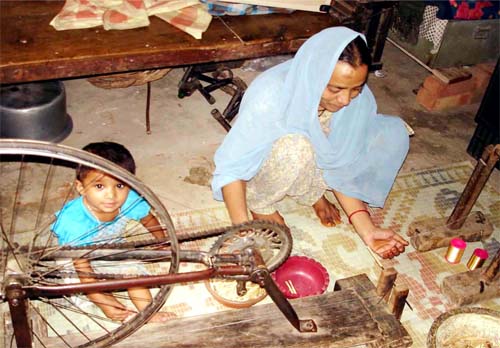Apr 15, 2025
Apr 15, 2025
by Tarannum
Few Indian bridal trousseaus are complete without the inclusion of an exquisite Benarasi sari. However, the women behind the creation of the spectacular yards of fabric have never been given their due. This, despite the fact that they are involved in the entire creative process - from weaving to adding embellishments to giving the final touches. (Varanasi, previously known as Benaras, has been a centre of production of saris made of finely woven silk and with intricate designs of 'zari' or golden thread.)

While the men have always been credited for their contribution to the industry, the women weavers now resolve to get a share of the recognition. "The women have now decided that they will make their presence felt. The weavers in Varanasi are suffering but the women endure much more because they are not even recognised as weavers," says Dr Lenin Raghuvanshi of the Peoples' Vigilance Committee for Human Rights (PVCHR) that works for the rights of the weavers in Varanasi, Uttar Pradesh.
Though the Benarasi silk industry is flourishing, the weavers have been working in pathetic conditions, living a life of abject poverty. There are about 11,000 weavers in Varanasi of which 43 per cent are women. On an average, the monthly earnings of a weaver are anywhere between Rs 500 to Rs 1,500; their female counterparts receive a paltry Rs 200 to Rs 400 a month (US$1=Rs 40).
Weaving is mainly a family business, with the skill handed down over generations, and the craftspersons working from their humble homes. In fact, there are no factories that manufacture the sari and thus shopkeepers source their spectacular wares from the homes. Around 80 per cent of the looms are manual and it takes about a week to a fortnight to complete a sari. Although women are rarely seen working directly on the looms, a visit to any weaver's home will reveal that without them, it would be impossible to create a Benarsi sari. Most of the women work to supplement their family incomes, particularly if the family is not in a position to hire workers. Some even work as contracted labour, though such instances are rare. "We have to continuously work for long hours, weaving designs into the saris, but in the end, it is the men who are known as weavers and we are just referred to as hired labourers," complains Lalti Devi, 48, a sari weaver in Lohata.
Benarasi saris are characterised by their intricate weave and heavy gold and silver brocade work. The women are responsible for filling 'zari' into the design, ensuring that the embroidery is taut, and also snipping off the extra threads from the finished product - all seemingly menial, but critical, strenuous and repetitive chores.
Women are not allowed to sit at the looms, believed to be far too physically demanding for their built. However, no attempts have been made to adapt the looms to their. Some women reason that the men feel threatened, fearing they would lose their jobs. "I have been working for the past decade and have learnt to weave a sari on the loom. Yet, I continue to just punch holes in the cardboard that eventually is used to guide the loom into weaving warp and weft jacquard patterns as per the punched pattern. For this I get a mere Rs 5 per day, although I work for six to eight hours at a stretch, as well," complains Sita Devi, 35, of Lohata.
In the Benarasi sari sector, it is women bear the brunt of cost cutting. In effect, this implies that had the women been given a fair remuneration for their jobs, the cost of production and of the subsequent finished product would have risen.
"I snip the unfinished threads of 15 to 20 saris per day and get just Rs 10 at the end of the day. But, tell me, if I don't cut the threads and finish the embroidery, will anyone buy the saris," questions Savitri, 38, a thread cutter from Lohata.
Ironically, since the women are not recognised in the sector, they are even deprived of benefits, such as healthcare. Dr Raghuvanshi says, "They suffer from back problems, poor eye sight and other problems. They have to shell out money for treatment as they do not fall under any (health) schemes and neither is there any specific government set-up for them. Their first need is to be recognised as weavers or as part of the sari-weaving sector. Only then can they ask for something."
Shrwanlal, 45, a weaver from Lohata candidly acknowledges the prevalent gender inequity, "We know that the women do a lot of significant things when it comes weaving a Benarsi sari. But we cannot let the money given to them be calculated as then they will also become an essential part of the sector and we will have to give them their share in almost everything."
01-Sep-2007
More by : Tarannum